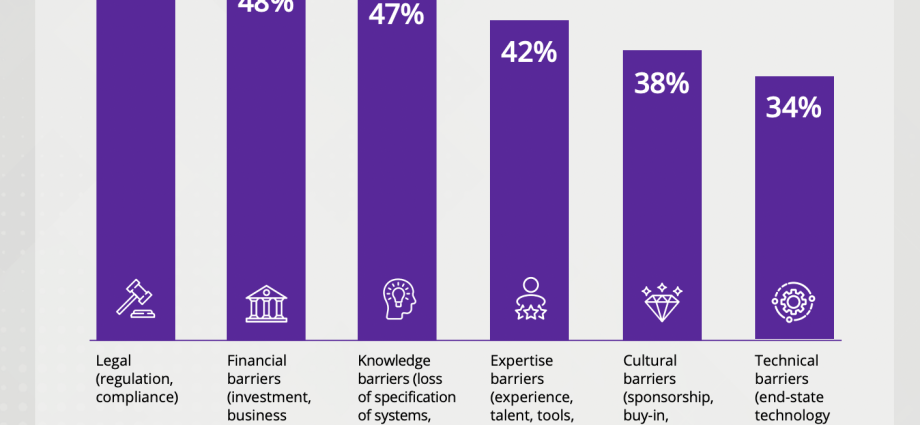- 99% of respondents recognised that technical debt is a risk to their organisations
- Lack of awareness significantly affects leaders’ ability to manage technical debt

A study of business leaders by DXC Technology, a leading Fortune 500 global technology services company, has revealed that nearly half (46%) of executives say that technical debt, or tech debt, is the silent saboteur inhibiting their ability to innovate and grow.
Tech debt is the implied cost of rework caused by choosing an “inferior but quick” solution over the “right” technology solution. In other words, while a past investment may have worked in the moment, it could fail to hold up well over time, the company said in a statement.
It added that tech debt tends to be a series of trade-offs that lead to suboptimisation and becomes increasingly hard to undo, and while different from obsolescence or depreciation, it can be measured in billions for most large enterprises and have far-reaching implications costing a business its talent, lower productivity, increased security risk, and ultimately be disruptive to an organisation’s success and stock price.
In a global survey of 750 C-suite information and technology executives commissioned by DXC Leading Edge, a team of experienced practitioners who create progressive thought leadership focused on business transformation. The Embracing modernisation: From technical debt to growth research makes the case for reframing tech debt from a problem that needs to be solved to something that needs to be tackled as part of any organisation’s modernisation efforts.
According to the report, there is an accountability crisis when it comes to tech debt. Of the executives interviewed, 99% recognised that tech debt was a risk to their organisations, despite the fact that three in four still believe that IT leadership should shoulder sole responsibility for fixing it.
Michael Corcoran, global lead, Analytics & Engineering, said, “We’re at a point in time where technology innovation is rapidly accelerating. The way we build, grow, and enable our teams and customers is changing and with that, our approach to managing the process of modernisation must as well.
“Sometimes the spread of tech debt across the organisation makes it hard for leaders to step outside of their team view, and this where a neutral third party can provide a holistic view that lets leaders consider a new perspective. If business leaders don’t commit to addressing tech debt now, it will lead to loss of resources, productivity, talent, and have huge security implications,” he added.
The survey indicates that lack of awareness among business leaders significantly affects their ability to manage technical debt. It highlighted that executives are clear about the barriers that hinder modernisation efforts in their organisations; 47% of respondents rated knowledge barriers as very or extremely significant, and 38% did the same for cultural barriers.
Additionally, DXC found that organisations can experience 39% in cost savings from reducing technical debt and retire 37% of redundant applications. As a response, they have identified a four-step plan to address today’s debt and prevent it in the future.

1. Reframe organisation debt as modernisation
Clearly articulating organisation debt is a way to ensure clarity of vision of the modernisation path. The shift toward future focus is essential, prompting candid executive conversations.
2. Define opportunities
The first step in defining modernisation opportunities is to expand the circle beyond IT accountability. In this instance, CIO and CTO will lead modernisation, with the entire executive team responsible for its success. Therefore, coordination between the business side and technical arm of the organisation is crucial. CTOs and CIOs are uniquely positioned to communicate organisation debt effectively to the C-suite and wider business stakeholders, with the CFO’s support, thus making the case clearly and convincingly to enable effective collaboration is the next step for these leaders.
3. Clear your barriers
Every industry has a unique profile, as would every organisation. Therefore, clearing organisational barriers is a matter of defining them in light of your inventory and Wardley Maps. Therefore, use your industry profile as a baseline and modify it for your organisation’s needs.
4. Organise for execution
After shifting the conversation, defining the barriers, and gaining alignment, the organisation can focus on its objectives and the impact of its activities. Modernisation is an ongoing collaborative process, involving not just the IT circle but the entire organisation. And when done properly, the benefits are felt across the whole organisation, from cost savings to carbon reduction, to improving employees’ work lives. When organisation debt is viewed clearly and articulated fully, it can be flattened, understood and managed thoughtfully as part of the balance sheet of a healthy business.
Dave Reid, research director of DXC Leading Edge, expressed that technical debt is a longstanding issue at the intersection of business and technology. It is well-known but often poorly understood.
“As it continues to accumulate, organisations worldwide cite it as a top challenge, inhibiting their ability to transform and serve their customers. Today we’re releasing our study to help our customers and partners tackle this issue head-on and begin to realize the long-promised but challenging benefits of modernisation and transformation,” he added.
In addition to the four ways organisations can use to manage tech debt, DXC has introduced The Tech Debt Audit for business leaders to immediately understand the level of tech debt in their organisations and identify their barriers to addressing tech debt.
For more information, explore DXC’s technical debt page here: Reframing Technical Debt

